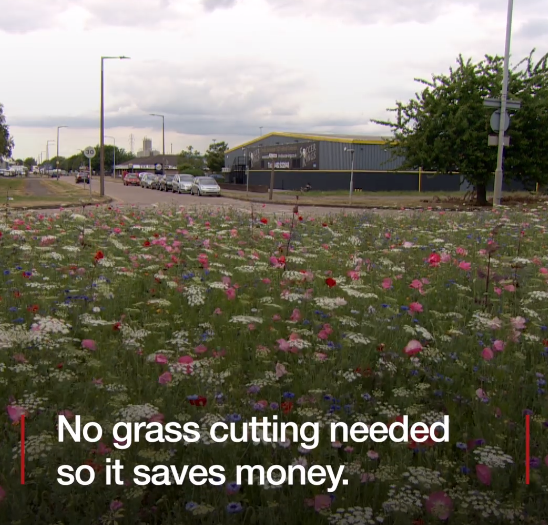Highways chiefs at Shropshire Council have given a poor answer to a question I asked about cutting grass verges. Anyone driving around Shropshire will note that many verges are cut unnecessarily at the cost of wildflowers and biodiversity. There are areas where regular verge cutting is essential. The response to a question I have asked for next week’s council meeting shows that Shropshire Council has little awareness of how verges could make a major contribution to biodiversity.
My starting point for the question at council next Thursday, other than my long interest in environmental matters and biodiversity, is a campaign being run by Plantlife to promote wildlife friendly verges. I was thinking of a question or motion at council subject to other business. Then the issue was raised by a villager at the last Local Joint Committee.
My choice was a ask question or put a motion. Questions dig out data and encourage portfolio holders to engage with issues. Motions, if successful, bind the council to action. I decided a question was appropriate at this stage. We get a written answer before the council meeting and then can ask a supplementary question without notice at the council meeting.
The answer from Steve Davenport, the portfolio holder for transport, is a disappointing reply. It doesn’t answer the first part of question directly and doesn’t address the second part at all.
The answer shows that Shropshire Council doesn’t understand how it can help biodiversity and save money at the same time. This reply is a view of biodiversity from a car driver’s window. It misses the essential point is that we are trying to create wildlife rich verges as well as protect them.
If Hull City Council can do it (it is well worth watching this video), why can’t Shropshire Council? The money we could save on unnecessary verge cutting could go into wildflower seeding or pothole filling.
Protecting and enhancing biodiversity should be a fundamental public duty. But Shropshire Council’s view is biodiversity lives in reserves and isolated pockets, while the rest of county gets more barren every year.
My question and the council answer
Councillor Andy Boddington will ask the following question to the Portfolio Holder for Highways and Transport:
The half a million kilometres of rural road verge in the UK is equal to around half of our remaining flower-rich grasslands and meadows. Wild flower verges are a vital ecological resource at a time when many countryside birds, moths, butterflies and insect species are in decline.
There are more than 5,000km of roads in Shropshire. Many lengths of verges must be cut regularly to ensure road safety. But many verges are being cut because they are on a schedule, rather than they need cutting for safety. This prevents many wildflowers from developing and seeding. That reduces the biodiversity of our county.
1) What account is taken of biodiversity in policies for verge cutting?
2) Has the council reviewed those policies against the road verge management guidelines presented by Plantlife in its Good Verge Guide?
Councillor Steve Davenport will reply:
We carry out regular safety inspections of our roads, and as part of the inspection process we aim to identify grass verges which have become overgrown and which may pose a hazard to highway users.
Verges are cut to:
- maintain visibility for road users, especially on road junctions, visibility splays and crossroads
- keep traffic signs clear
- keep verges passable for pedestrians, horse riders and cyclists
Verges provide important habitats for a variety of species of insects and animals. Asa consequence, we cut a limited width of most rural verges only once a year. By keeping the width of cutting to a minimum, the remaining verge area can provide an important habitat for wildflowers and wildlife.
Wild flower rich road verges can be reported on line via the link below: https://shropshire.gov.uk/environment/biodiversity-ecology-and-planning/wildflowerrich-road-verges/
We’ll find the location of your verge and our Natural Environment and Highways teams will update their map-based records.The information provided about the verge will be assessed by our Natural Environment team.
Where safe to do so, the Highways team will ensure the verge is managed appropriately using the guidelines provided by Plantlife. There are many logistical challenges involved in managing particular areas of verge within the wider network. Every effort is made to ensure our staff and contractors adhere to these specific maintenance requirements where possible. However, road traffic and pedestrian safety must be prioritised at all times, and may lead to areas requiring more thorough works outside of the specified environmental interest requirements.


HEAR, HEAR, Andy … and that applies to all areas of the county.
Don’t they know that breading beards and their chicks need to be left along and in peace in the Spring until the little ones have flown the nest … like us, really … only for our offspring, the minimum, for those who who go to uni, it’s 18 years!